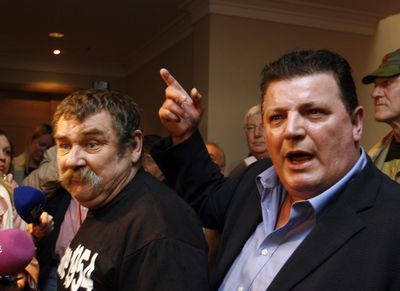Report details child abuse in Ireland
Thousands affected from 1930-’90 in Catholic-run schools

LONDON – Thousands of children were physically and sexually abused by priests and nuns in orphanages and reform schools in Ireland from 1930 to 1990, a government commission said Wednesday in the first official accounting of the full magnitude of a scandal that has wrenched the deeply Roman Catholic nation.
The 2,600-page report, which capped a nine-year investigation, said rape and sexual abuse were “endemic” in boys’ institutions funded by the state but run by the church. “A climate of fear, created by pervasive, excessive and arbitrary punishment, permeated most of the institutions and all those run for boys,” it said.
More than 300 people who now live abroad, including in the United States, returned to Ireland to testify at 166 hearings on what happened to them in schools and group homes. In all, more than 1,000 people, most now in their 50s or older, described rapes, molestation, floggings, scaldings and other abuse.
For decades, Ireland educated tens of thousands of orphans and other children ages 5 to 16 – including some with disabilities and others born to unwed mothers or with histories of petty crime and truancy – in more than 200 crowded, 19th-century institutional homes that had largely been shut down by 1990. Although the government paid for them, religious orders ran them.
The commission was set up by the Irish government. Already worried about declining church attendance, many priests had warned parishioners in recent Sunday homilies that the report would “shock us all,” as the archbishop of Dublin, Diarmuid Martin, said last month.
“I am profoundly sorry and deeply ashamed,” Cardinal Sean Brady said after the report was released on Wednesday in Dublin. “Children deserved better and especially from those caring for them in the name of Jesus Christ.”
The commission said documents found at the Vatican showed that religious orders knew of numerous abuse complaints but covered them up, worried more about scandal than about protecting children.
The Christian Brothers ran many of the residential boys homes in Ireland, and more allegations were made against it than against all the other male religious orders combined. The Christian Brothers successfully sued the commission in 2004 to keep the identities of its members unnamed, noting that many of the brothers were dead and could not defend themselves.
In the end, no priest or nun was named in the report – a fact many of the victims groups decried, because the findings would not aid those pursuing criminal prosecutions. “It’s deeply flawed, incomplete, a whitewash,” John Kelly, coordinator of the Survivors of Child Abuse, an Irish victims’ group, told reporters in Dublin.
John Walsh, who described himself as a victim of abuse, told Irish reporters that he was “very angry, very bitter” that no priests were named. “I feel cheated and deceived. I would have never opened my wounds if I’d known this was going to be the end result.”
Some church defenders suggested that victims may have exaggerated their claims. But many Irish commentators portrayed the report as a devastating indictment of both the church and the state. The Irish government has paid compensation to 12,000 abuse victims, and more claims are pending.
The report strongly criticized the Irish Education Department for lack of oversight, describing how a state inspector could be responsible for as many as 50 schools and would typically announce his visits in advance and neglect to talk to children.
In general, the commission found, the severe physical and sexual abuse that occurred in boys’ schools was absent in girls’ schools. But it said “emotional abuse,” including humiliation and denigration, was common in institutions for girls. Also, it said, in some girls’ schools “a high level of ritualized beating was routine,” and “girls were struck with implements designed to maximize pain and were struck on all parts of the body.”